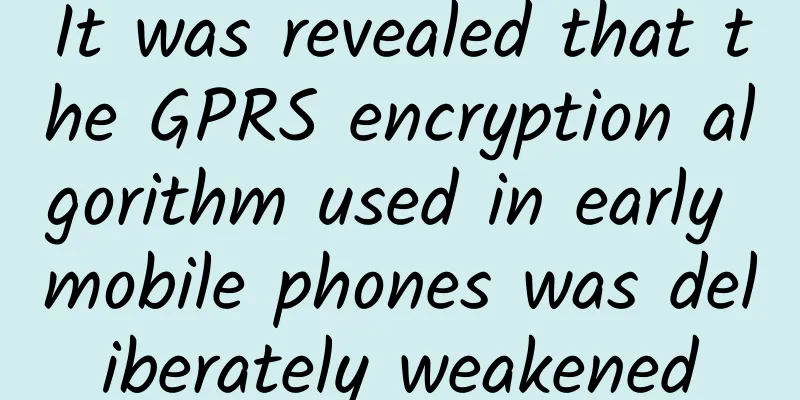It was revealed that the GPRS encryption algorithm used in early mobile phones was deliberately weakened

|
A team of researchers from several European universities has just pointed out in a paper that the vulnerability of the GPRS encryption algorithm used in early mobile phones was not accidental. Subsequent facts have proved that their suspicions were correct. As Vice highlights, GEA-1 was mainly used for mobile phone data encryption in the 1990s and 2000s. The algorithm was originally thought to provide full 64-bit encryption security, but in their cryptanalysis, the research team found that its security was actually limited to 40 bits at design time. To further verify the finding, the research team also obtained more details about the GEA-A and GEA-2 algorithms from unnamed sources so that they could conduct a comprehensive analysis and identify weaknesses. The results confirmed the "unlikely" coincidence. TechSpot pointed out that an attacker with the ability to intercept a phone's data traffic could exploit the vulnerability to decrypt all messages in a conversation. Vice also contacted the European Telecommunications Standards Institute (ETSI), which designed the GEA-1 encryption algorithm, and a spokesperson for the organization acknowledged in an email statement that the algorithm does contain a weakness. But the reason it was introduced is that it was required to be present because ETSI needed to comply with export control regulations that limited the strength of GEA-1. Such export controls were fairly common given the international situation at the time, and The Register reported that France had enacted a similar rule that banned anything over 40-bit encryption. Håvard Raddum, who participated in the new research, complained: "In order to cater to these restrictive policies, millions of users have been unable to obtain the safe online protection they should have for a long time." However, the biggest problem revealed by this study is that no export controls were explicitly mentioned when the GEA-1 standard was formulated and launched. Moreover, the research team found that even though the difficulty of technical operation has increased, the GEA-2 algorithm is still vulnerable to attacks. Thankfully, neither standard has gained widespread adoption, with vendors preferring newer, more secure encryption algorithms — although networks in some markets still use them as a fallback. |
<<: What is data-driven design?
>>: Don’t know how to design buttons? Just master these 5 golden rules
Recommend
This large scientific device is about to start construction! What exactly is the attosecond, which is known as the fastest "flashlight" in human history?
According to news from Songshan Lake Science City...
66 Douyin professional terms that Douyin operators must know
Entering 2020, Douyin has accelerated its pace of...
Zhihu promotion strategy for small household appliances!
1. Company Introduction Client K is a brand that ...
Beichen Asia Market: Analysis of Beijing Automobile Market in May 2024
New car transactions In May, Beijing's new ca...
Understand the rise, turning point and breakthrough of Internet finance in one article!
The rapid rise of any industry is not accidental....
Opinion: We have overestimated the economic benefits of artificial intelligence
Are we overestimating the impact of generative AI...
Google will shut down account login for Android 2.3.7 and earlier versions
[[414551]] According to foreign media 9to5Google,...
iPhone 7 performance test: A10 processor beats all other processors
We have experienced the powerful performance of iP...
Why can't LG "copy" Samsung's success?
For Chinese consumers, LG is another Korean techn...
Muxi Reading 1.5.1 A huge amount of resources for you to choose from
【Software Description】 Muxi reading software is a...
How to improve editing skills in short videos? What editing tools do beginners use?
The food short videos shot by the aunt next door ...
Introduction to the process of placing native dynamic product ads on Baidu!
What are native dynamic product ads? Native Dynam...
Data-driven design: How to improve registration conversion rate?
Data-driven is a buzzword. Many Internet companie...
Analysis of user fission growth in Internet communities
With the development of my country's Internet...
Yizhuo.com’s product removal phone number is unreachable: the money-burning model of fresh food e-commerce is difficult to sustain
During this period, Ms. Liu, a citizen, found tha...









